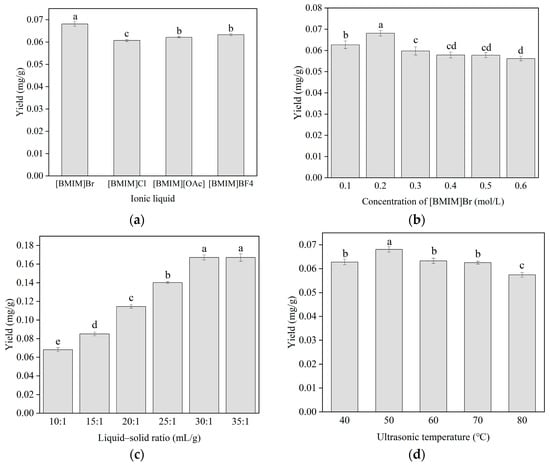Taraxacum mongolicum Hand.-Mazz. is a perennial herb of the genus Dandelion, family Asteraceae, which can be used as medicine, and its stems and leaves can be eaten raw [
1,
2]. As a medicinal plant, dandelion has anti-colitis, anti-viral, antibacterial, anti-arthritic, anti-cancer, diuretic, and hepatoprotective properties [
3]. The major active components of dandelion are flavonoids, carotenoids, phenolic acids, polysaccharides, and sterols [
4,
5]. Flavonoids have strong antioxidant activity and can scavenge free radicals involved in the antioxidant response to protect the body from chronic diseases and inflammation [
6]. Quercetin belongs to the group of flavonols with biological activities such as anti-inflammatory, antioxidant, anti-cardiovascular, anti-tuberculosis, anti-diabetic, and anti-malarial [
7] activities. In addition, quercetin promotes the proliferation of human fibroblasts and increases the hyaluronic acid and collagen content of human fibroblasts.
Extraction methods for quercetin include maceration, soxhlet distillation, and thermal reflux extraction [
8]. However, these techniques require a longer processing time, higher temperatures, and large amounts of solvents, are environmentally unfriendly, and are not cost-effective. Therefore, to overcome these drawbacks, an ionic liquid–enzyme complex system-assisted ultrasonic extraction of quercetin from dandelion was successfully employed in this study. Ionic liquids (ILs), also known as molten salts, have a lower melting point of 100 °C and serve the dual function of solvent and catalyst [
9]. Compared with organic solvents, ionic liquids have higher extraction efficiency, good thermal and chemical stability, and less contamination [
10]. Ionic liquids can be used for the extraction of natural products and their extraction efficiency is related to the structure of anions and cations [
11]. Cations mainly include imidazolium, ammonium, pyridinium, phosphonium, sulfonium, and pyrrolidinium. Anions include halides, acetate, nitrate, hydrogen, and sulfate. It has been found that IL anions affect extraction efficiency through hydrogen bond strength and hydrophobicity [
12]. The use of ILs for the extraction of flavonoids has been reported. Zeng et al. studied the extraction of rutin from bitter ginseng by 1-butyl-3methylimidazole ionic liquid with different anions. It was found that the aqueous 1-butyl-3methylimidazole bromide solution gave the best results [
13]. Zhao et al. investigated the feasibility of ionic liquids based on ultrasound-assisted extraction of resveratrol from
Polygonum cuspidatum. The results showed that the yield of resveratrol could reach 2.90 ± 0.15 mg/g by using 0.5 mol/L 1-butyl-3methylimidazolium bromide as the extraction solvent. Ionic liquids can be used as an alternative to conventional volatile organic solvents [
14]. Ultrasound-assisted extraction (UAE) uses high-intensity ultrasound to accelerate the interparticle collision, leading to the fragmentation of cell structures and the overflow of active ingredients [
15]. Ionic liquid-based ultrasonic-assisted extraction (IL-UAE) can effectively extract active ingredients from plants, such as alkaloids [
16], flavonoids [
17], ginsenosides [
18], and terpenoids [
19]. Enzymes commonly used in enzyme-assisted extraction methods include cellulase and pectinase, mainly through the enzyme degradation or destruction of cell walls and membranes, which can better release and effectively extract biologically active substances, and is characterized by a fast extraction speed, low dosage, and low energy consumption [
20,
21]. Network pharmacology uses systems biology as a guide and combines techniques from multiple disciplines to study disease–drug interactions [
22]. By predicting the active ingredient targets and possible disease targets of Chinese herbal medicines and constructing a “component-target-pathway” network, the main active ingredients and mechanisms of action of Chinese herbal medicines will be explored [
23].
Fewer studies have reported on the extraction process of quercetin from dandelion, mainly focusing on the extraction of total flavonoids from dandelion. In this study, the ultrasonic-assisted extraction of quercetin from dandelion was carried out using an ionic liquid–enzyme complex system, and the content of quercetin in the extract was determined by high-performance liquid chromatography. Based on a single factor, response surface methodology was applied to optimize the extraction conditions, with a view to providing technical references for the utilization of quercetin in dandelion. The prediction of quercetin action targets and antioxidant targets based on network pharmacology and the construction of a component–target–function network provide new ideas for the study of quercetin antioxidant effects.
Source link
Jingwei Hao www.mdpi.com


